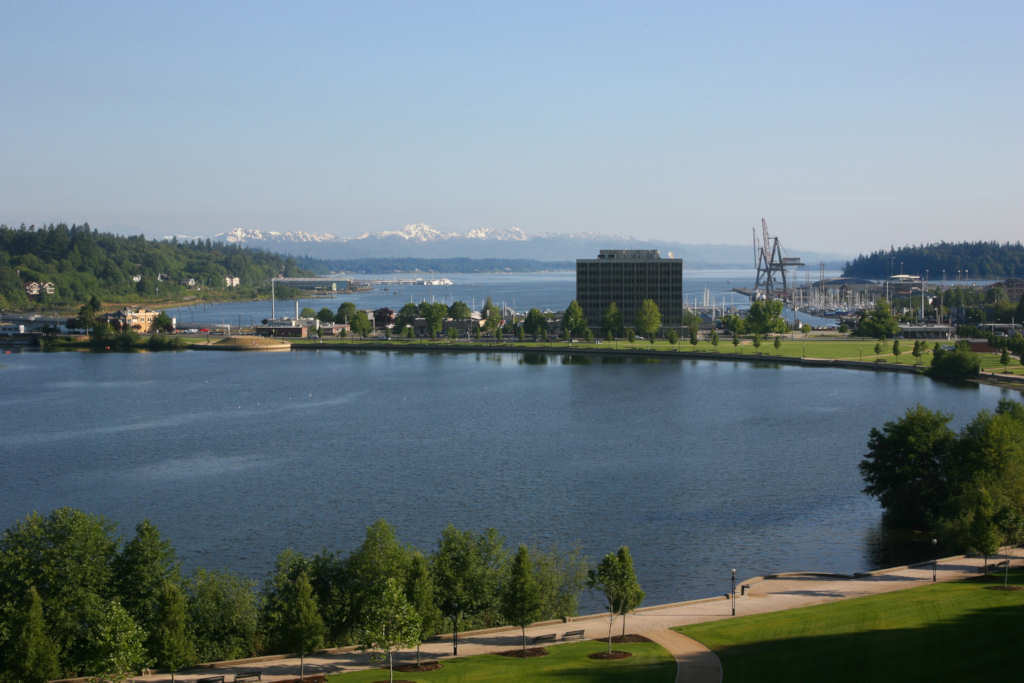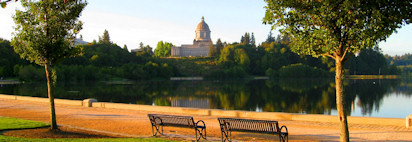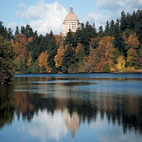Frequently Asked Questions - and the Answers - about Capitol Lake
Questions & answers about why about why saving Capitol Lake is so important to the City of Olympia, Washington.
What is the problem with Capitol Lake?
The last time the lake was dredged (partially) was in 1986. Since that time nearly one million cubic yards of sediment has flowed down the Deschutes River into the lake and Budd Inlet. This has resulted in the lake becoming very shallow and subject to excessive warming during summer months. It has also resulted in the need for dredging in Budd Inlet.
Currently, the Port of Olympia plans to spend over $10 million on dredging and the Olympia Yacht Club will spend $1 million to remove sediment. Sediment build-up also threatens Percival Landing. Action is urgent since sediment has nearly filled the lake and is now beginning to fill the boating channels of Budd Inlet.
Why was this allowed to happen?
By law (RCW 79.24.700 and RCW 79.24.710) the lake is a part of the State Capitol campus and subject to the policy direction of the State Capitol Committee. The Department of Enterprise Services is responsible for its maintenance. Since the 1980s millions of dollars have been spent to study the lake but it has not been properly maintained, resulting in its current poor condition.
In 2009, an advisory committee strayed from its legislative mandate to evaluate Capitol Lake maintenance options. Instead it advocated for converting the lake to a tidal mud flat and removing the Fifth Avenue dam.
Officials and citizens began reviewing the committee's proposal and the multitude of studies, and identified fatal flaws in the conversion idea. The proposal didn’t address the sources of pollution and sediment management within the Deschutes River system. It also didn’t address the associated economic, aesthetic, architectural, and social impacts that would result if the dam were removed.
What has been the local response?
After reviewing the advisory committee recommendations, local citizens formed a grass-roots non-profit organization (CLIPA) to identify watershed-wide solutions for improving water quality and sediment management in a cost-effective way, recognizing the critical role Capitol Lake serves in the ecosystem, the community, and the Capitol Campus.
CLIPA assembled a Science and Policy Panel to review the environmental, economic and financial issues surrounding dam removal and commissioned third party papers on aspects of the lake. CLIPA has proposed a three point plan that includes maintenance dredging and watershed-wide coordinated action with input from all stakeholders.
In 2011, the legislature provided $200,000 to initiate permitting for maintenance dredging. CLIPA will continue to work to increase community awareness and encourage the legislature to continue to support and improve the lake.
How did the lake come to be?
Capitol Lake is an integral part of the nationally significant Wilder and White “City Beautiful” plan for the State Capitol campus. The 1911 plan called for construction of a dam at Fifth Avenue to provide a reflecting lake for the monumental buildings on the bluff.
As one of the architectural elements of the campus, the lake was completed in 1951. It ended years of odorous mud flats, provided flood protection and allowed for the development of downtown Olympia into a pre-eminent Capital City. The lake also greatly enhances our urban environment, providing a beautiful setting for social gatherings, recreation, business, and tourism. It has been rated the number one “Jewel” of Thurston County.
Would removing the dam provide environmental benefits?
Advocates of restoring tidal mud flats suggest improved environmental benefits. Such assumed benefits would be few, if any, and the existing benefits of the dam would be eliminated.
Capitol Lake has created a unique transition zone between the Deschutes River and Puget Sound. It supports a wide variety of aquatic life. Its high productivity supports birds and our iconic local bat population1 that would be decimated if the dam were removed. There was no significant native salmon run prior to the lake, which helps support the hatchery-created salmon run.
Returning to tidal mud flats would greatly diminish if not eradicate most of these benefits. Removing the dam will triple the predation areas harmful to the salmon.
1 See our Links page for sites about the bat population
What about water quality? Would it improve by converting the lake to tidal mud flats?
Simply allowing the pollution to continue into Budd Bay to be diluted and less noticeable solves nothing. However, a properly managed watershed will solve many problems such as bacterial contamination, high temperatures, and low dissolved oxygen entering the lake.
Effectively addressing upstream contaminants and the over 80 storm water outfalls will improve water quality and allow a return to a wide range of recreational uses of the Lake.
What about the snails?
The mud snails are a growing problem along the West Coast and are not unique to Capitol Lake. They enjoy a brackish environment so the tide flat alternative will not fix the problem. Experts are working hard to address the issue. Saving the lake would not make the problem worse.
Which would cost less, preserving the lake or reverting to tidal mud flats?
Preserving the Lake would cost far less. The CLIPA 50-year plan is estimated to cost about $50 million compared to approximately $200 million to remove the dam, build a new bridge, retrofit Deschutes Parkway and complete other necessary projects.
Missing from the conversion estimates are the massive costs due to shifting dredging from Capitol Lake to the entire lower Budd Inlet. According to evidence from the Port of Olympia’s experience, dredging costs would be higher in marine waters where it is more expensive to collect and dispose of materials compared with the managed lake option CLIPA proposes. According to state estimates, 6 feet of sediment will accumulate in lower Budd Inlet every 10 years!
Are there economic benefits of returning to tidal mud flats?
There are no economic benefits of turning the lake into tidal mud flats. In fact, it would negatively affect the over $80 million in investments already made by the State and the community in Heritage Park, Marathon Park, Percival Landing, West Bay Park and Rotary Point, as well as future plans.
Water dependent activities would also be adversely affected. Olympia’s downtown will be significantly impacted due to loss of waterfront businesses and degraded aesthetics.
How does the community feel about the lake?
Local candidates who have door belled in the community reported that an estimated 80% of residents favored retaining Capitol Lake, 15% didn’t understand the issue but did not like the lake’s current condition and wanted it improved, and about 5% supported the tide flat conversion.
Why should people outside of the City of Olympia’s downtown core care about this issue?
The lake is an asset enjoyed by residents throughout the county, region and state. It contributes to Washington having one of the most beautiful Capitol Campuses and Capital Cities in the nation. Capitol Lake is a resource for all state residents and visitors to its Capital City.
What can I do?
- Learn more about the issues and options
See CLIPA's White Paper
and many 3rd party science & economic reviews - Add your voice to those who want to save the lake. Join CLIPA, it’s free!
- Get involved in activities related to the lake.
- Encourage your friends to get involved.
- Ask legislators and other elected officials to support legislation to improve the lake and the Deschutes watershed.
- Ask questions of candidates as to where they stand on the issue.
Frequently Asked Questions - and the Answers
by: CLIPA Capitol Lake Improvement & Protection Assn. (July 2010)Frequently asked questions, with answers, about why Saving Capitol Lake is so important to the City of Olympia, Washington.


